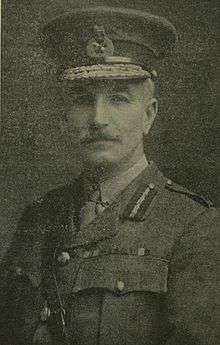William Marshall (British Army officer)
| Sir William Marshall | |
|---|---|
 Lieutenant General Sir William Marshall | |
| Born |
29 October 1865[1] Stranton, near Hartlepool, County Durham, England |
| Died |
29 May 1939 (aged 73) Bagnoles-de-l'Orne, France |
| Allegiance |
|
| Service/branch |
|
| Rank | Lieutenant General |
| Commands held | Southern Army, India |
| Battles/wars |
Second Boer War First World War |
| Awards |
Knight Grand Cross of the Order of St Michael and St George Knight Commander of the Order of the Bath Knight Commander of the Order of the Star of India |
Lieutenant General Sir William Raine Marshall GCMG KCB KCSI (29 October 1865 – 29 May 1939) was a British Army officer who in November 1917 succeeded Sir Frederick Stanley Maude (upon the latter's death from cholera) as Commander-in-Chief of the British forces in Mesopotamia. He kept that position until the end of the First World War.
Biography
Marshall was born the village of Stranton, near Hartlepool, County Durham. He was the younger son of solicitor William Marshall and his wife, Elizabeth (née Raine).[1]
He first went to Repton School and then Royal Military College, Sandhurst. He received a commission into the Sherwood Foresters in 1886, after which he served on the Malakand expedition, on the North West Frontier and on the Tirah expedition before fighting in the Second Boer War.[2] Following the end of the war, in late May 1902, Marshall received a brevet promotion to lieutenant-colonel in the South African Honours list published on 26 June 1902.[3]
Commanding Officer of 1st Battalion Sherwood Foresters on the Western Front during 1914-15, Marshall was then posted to command 87th brigade of 29th Division in the ill-fated expedition to Gallipoli,[2] during which he received a promotion to Major-General in June 1915.
A series of divisional commands followed: 42nd, 29th, and 53rd, before he was posted to Salonika with 27th Division, and then with III (Indian) Corps on the Mesopotamian Front.[2] It was while commanding III Corps that Marshall participated in the capture of Kut-al-Amara in February 1917, and in the capture of Baghdad the following month.
With Sir Frederick Maude's death as Commander-in-Chief from cholera (most probably from contaminated milk), the hugely popular commander was replaced by the careful and meticulous Marshall,[2] appointed by Sir William Robertson at the War Office in London, the latter determined to scale back operations in Mesopotamia.
It was in this capacity that Marshall accepted the surrender of the Ottoman army at Mosul on 30 October 1918, with the signing of the Armistice of Mudros.[1]
His post-war career took him back to India commanding the Southern Army and remaining there until 1923;[2] he retired the following year.[2]
Marshall was appointed a Companion of the Order of the Bath in 1916. He was knighted three times — as a Knight Commander of the Order of the Bath (1917), Knight Commander of the Order of the Star of India (1918) and Knight Grand Cross of the Order of St Michael and St George (1919)[1]
He died at Le Grand Hôtel, Bagnoles-de-l'Orne, France. He was survived by his wife, Emma Cundell, whom he married in 1902.[1]
References
- 1 2 3 4 5 F. B. Maurice, Marshall, Sir William Raine (1865–1939), rev. Roger T. Stearn, Oxford Dictionary of National Biography, Oxford University Press, 2004; accessed 19 October 2016]
- 1 2 3 4 5 6 Liddell Hart Centre for Military Archives
- ↑ The London Gazette: (Supplement) no. 27448. pp. 4191–4194. 26 June 1902.
- Archives Hub: MARSHALL, Lt Gen Sir William Raine (1865-1939) at www.archiveshub.ac.uk
Further reading
- Marshall, Lieutenant General Sir William, Memories of Four Fronts. London: Ernest Benn Ltd, 1929.
| Military offices | ||
|---|---|---|
| Preceded by Sir Charles Anderson |
GOC-in-C, Southern Army, India 1919 – 1923 |
Succeeded by Sir Andrew Skeen |